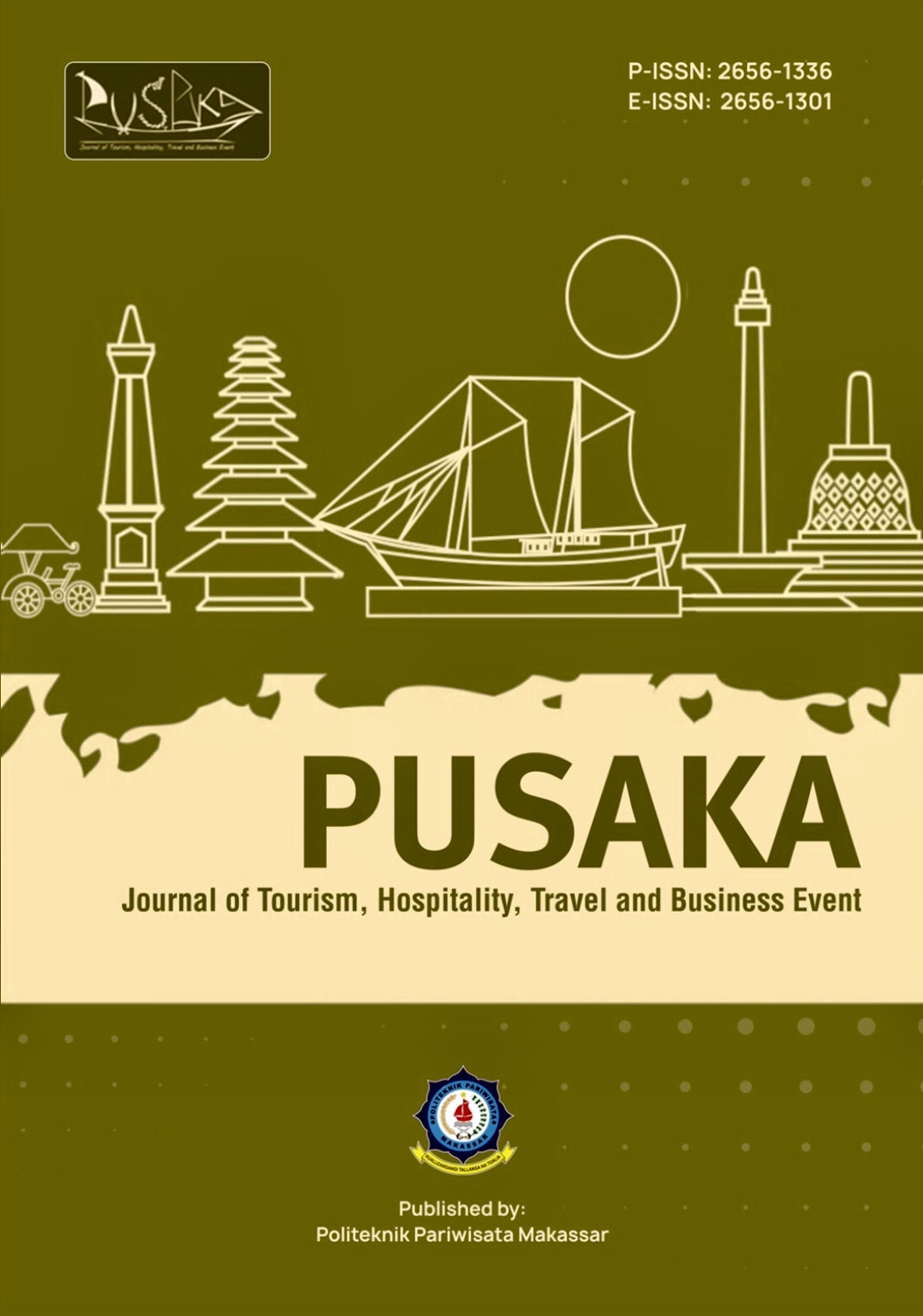Pemanfaatan Hutan Kota Sebagai Destinasi Wisata Edukasi
DOI:
https://doi.org/10.33649/pusaka.v2i2.60Keywords:
Hutan Kota, Destinasi, Wisata EdukasiAbstract
Unsur terpenting dari penelitian ini adalah informasi tentang potensi wisata yang dimiliki oleh kabupaten Jeneponto utamanya pada Kecamatan Binamu Kelurahan Balang, perihal hutan kota yang dapat dijadikan destinasi wisata perkotan yang sifatnya alami, pendekatan edukasi. dengan melalui methode survey, hasil tinjauan dilapangan menggambarkan bahwa potensi hutan kota ini dapat dijadikan alternatif lain dalam aktivitas wisata bagi wisatawan lokal maupun dari luar kota yang ingin melakukan aktivitas wisata alam, namun sebelumnya harus dilakukan penatan yang baik dengan berbagai upaya dan keterlibatan dari semua lini baik itu pemerintah daerah, masyarakat, komonitas, hingga infestor yang ingin membangun kawasan tersebut. Meskipun tidak mudah dalam perencanaannya karena dibutuhkan pemeikiran mendalam terhadap methode, bentuk, bahkan irama pengelolaannya kedepan, diharapkan dengan penelitian ini akan memberi sumbangan positif untuk pengkajian selanjutnya.
References
Astell-Burt, T., & Feng, X. (2020). Does sleep grow on
trees? A longitudinal study to investigate potential
prevention of insufficient sleep with different types of
urban green space. SSM - Population Health, 10(June
, 100497.
https://doi.org/10.1016/j.ssmph.2019.100497
Cho, S. H., Poudyal, N. C., & Roberts, R. K. (2008).
Spatial analysis of the amenity value of green open
space. Ecological Economics, 66(2–3), 403–416.
https://doi.org/10.1016/j.ecolecon.2007.10.012
Garcia-Garcia, M. J., Christien, L., García-Escalona, E., &
González-García, C. (2020). Sensitivity of green
spaces to the process of urban planning. Three case
studies of Madrid (Spain). Cities, 100(December
, 102655.
https://doi.org/10.1016/j.cities.2020.102655
Humaida, N., Prasetyo, L. B., & Rushayati, S. B. (2016).
Priority Assessment Method of Green Open Space
(Case Study: Banjarbaru City). Procedia
Environmental Sciences, 33, 354–364.
https://doi.org/10.1016/j.proenv.2016.03.086
Joo Ahn, J., Kim, Y., Lucio, J., Corley, E. A., & Bentley,
M. (2020). Green Spaces and Heterogeneous Social
Groups in the U.S. Urban Forestry & Urban Greening,
(September 2019), 126637.
https://doi.org/10.1016/j.ufug.2020.126637
Kristianto, Vigi hery. Metodologi Penelitian pedoman
penulisan karya ilmiah (KTI),ISBN 978-602-473-274-
, september 2018, yokyakarta
Lee, B. K., Sohn, S. Y., & Yang, S. (2014). Design
guidelines for the Dashilar, Beijing open green space
redevelopment project. Urban Forestry and Urban
Greening, 13(2), 385–396.
https://doi.org/10.1016/j.ufug.2013.12.008
Lee, M. B., Peabotuwage, I., Gu, H., Zhou, W., &
Goodale, E. (2019). Factors affecting avian species
richness and occupancy in a tropical city in southern
China: Importance of human disturbance and open
green space. Basic and Applied Ecology, 39, 48–56.
https://doi.org/10.1016/j.baae.2019.08.003
Mell, I. (2020). The impact of austerity on funding green
infrastructure: A DPSIR evaluation of the Liverpool
Green & Open Space Review (LG&OSR), UK. Land
Use Policy, 91(August 2019).
https://doi.org/10.1016/j.landusepol.2019.104284
Musawantoro, M., & Ridwan, M. (2019). Potensi Pantai
Panrangluhung di Bira Kabupaten Bulukumba sebagai
Destinasi Wisata. Jurnal Kepariwisataan: Destinasi,
Hospitalitas Dan Perjalanan, 3(1), 1–7.
https://doi.org/10.34013/jk.v3i1.27
Ordóñez, C., Threlfall, C. G., Livesley, S. J., Kendal, D.,
Fuller, R. A., Davern, M., … Hochuli, D. F. (2020).
Decision-making of municipal urban forest managers
through the lens of governance. Environmental Science
and Policy, 104(May 2019), 136–147. https://doi.org/10.1016/j.envsci.2019.11.008
Schuch, G., Serrao-Neumann, S., Morgan, E., & Low
Choy, D. (2017). Water in the city: Green open spaces,
land use planning and flood management – An
Australian case study. Land Use Policy, 63, 539–550.
https://doi.org/10.1016/j.landusepol.2017.01.042
Sonti, N. F., Campbell, L. K., Svendsen, E. S., Johnson,
M. L., & Novem Auyeung, D. S. (2020). Fear and
fascination: Use and perceptions of New York City’s
forests, wetlands, and landscaped park areas. Urban
Forestry and Urban Greening, 49, 126601.
https://doi.org/10.1016/j.ufug.2020.126601
Trlica, A., Hutyra, L. R., Morreale, L. L., Smith, I. A., &
Reinmann, A. B. (2020). Current and future biomass
carbon uptake in Boston’s urban forest. Science of the
Total Environment, 709, 136196.
https://doi.org/10.1016/j.scitotenv.2019.136196
Xue, F., Gou, Z., & Lau, S. S. Y. (2017). Green open
space in high-dense Asian cities: Site configurations,
microclimates and users’ perceptions. Sustainable
Cities and Society, 34, 114–125.
https://doi.org/10.1016/j.scs.2017.06.014
Žlender, V., & Gemin, S. (2020). Testing urban dwellers’
sense of place towards leisure and recreational periurban green open spaces in two European cities. Cities,
(July 2019).
Downloads
Published
How to Cite
Issue
Section
License

This work is licensed under a Creative Commons Attribution-ShareAlike 4.0 International License.






















